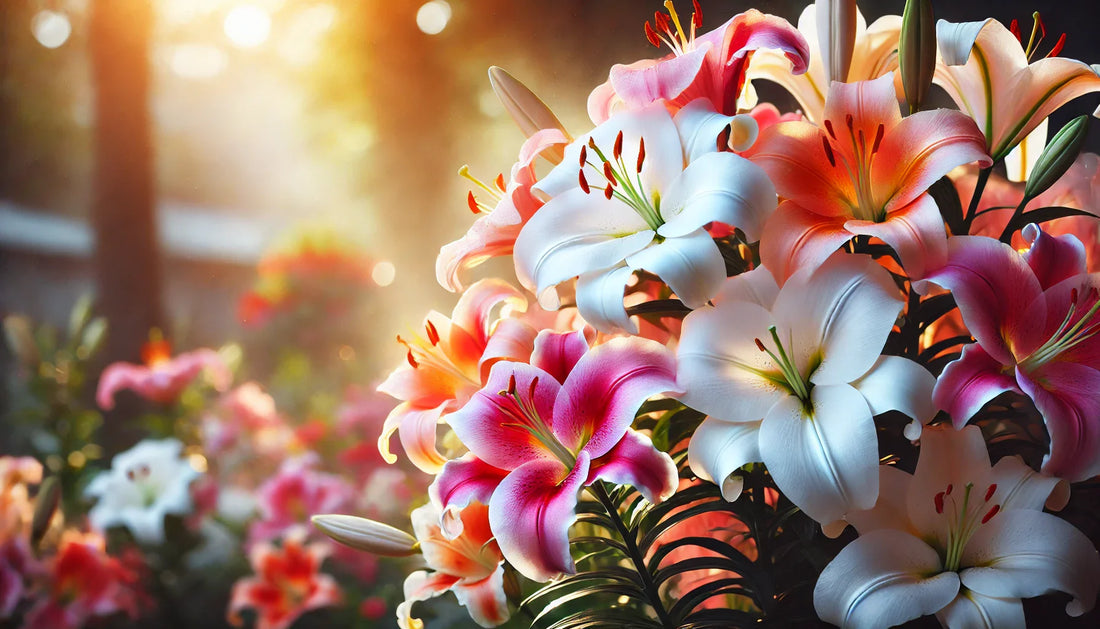
Lilies: Beauty, Symbolism, and Healing
Cody ManesShare
A Flower of Beauty and Symbolism
Lilies are among the most revered and cherished flowers in history, known for their elegant beauty, enchanting fragrance, and deep symbolic meanings. These delicate yet resilient blooms belong to the Lilium genus, which comprises over 100 species, each showcasing unique colors, patterns, and scents. From the towering white Madonna lily to the vibrant Asiatic and Oriental hybrids, lilies have captivated cultures across the globe, often serving as symbols of purity, transformation, and even the divine.
Throughout history, lilies have been woven into mythology, religious iconography, and folklore. They have graced the gardens of emperors, been used in sacred rituals, and even held medicinal significance. Their presence in art and literature only amplifies their allure, making them one of the most admired flowers in the world. But beyond their aesthetic charm, lilies possess powerful spiritual, emotional, and even protective properties that have fascinated people for centuries.
The Historical Significance of Lilies
Lilies have a rich history that spans continents and civilizations. In ancient Egypt, they were associated with rebirth and were often found in tombs, symbolizing the transition to the afterlife. The Greeks and Romans linked lilies to divine figures such as Hera and Venus, believing that the flowers sprang from the milk of these goddesses. This association with purity and divinity made lilies a central motif in religious art and iconography, particularly in Christianity, where they became a symbol of the Virgin Mary.
In Asia, lilies have long been revered for their auspicious meanings. In Chinese culture, lilies symbolize good fortune, harmony, and a hundred years of love, making them a popular choice for wedding bouquets. The Japanese also regard lilies as representations of refined beauty and tranquility, often incorporating them into traditional tea gardens and floral arrangements.
During the Middle Ages, lilies were cultivated in monastery gardens and used for medicinal purposes. Monks and herbalists utilized their extracts to treat ailments ranging from fevers to digestive disorders. Their importance continued to grow in European culture, with Renaissance painters often depicting lilies in religious and mythological scenes to emphasize themes of purity and transcendence.
The Spiritual Properties of Lilies
Beyond their historical significance, lilies carry deep spiritual meaning and are often associated with enlightenment, renewal, and the connection between the physical and divine realms. Many cultures believe that lilies possess a high vibrational energy, making them ideal for spiritual practices such as meditation, ritual work, and energy cleansing.
White lilies, in particular, are thought to amplify positive energies and promote inner peace. They are often used in ceremonies to honor deities, ancestors, or spiritual guides. Some practitioners place fresh lilies on altars to enhance their connection to higher consciousness, believing that the flower's scent carries messages between realms.
Lilies are also associated with transformation and rebirth. Their blooming cycle mirrors the journey of spiritual awakening, as they emerge from bulbs hidden beneath the soil before blossoming into stunning, fragrant blooms. This makes them a powerful symbol for those seeking personal growth, healing, or renewal after hardship.
Emotional and Psychological Benefits of Lilies
The mere presence of lilies can have a profound impact on one's emotional well-being. Their gentle yet intoxicating fragrance has been shown to reduce stress and promote relaxation, making them a favorite choice for aromatherapy and floral arrangements in calming spaces. Many people find that having lilies in their home fosters a sense of tranquility and balance.
Lilies are also associated with emotional healing and comfort. They are often given as gifts to convey sympathy and support, particularly in times of grief. Their ethereal beauty reminds us of life's fleeting nature while offering reassurance and hope. The act of tending to lilies, whether in a garden or as cut flowers, can also be therapeutic, helping individuals cultivate mindfulness and appreciation for the present moment.
The Protective Qualities of Lilies
In addition to their beauty and spiritual significance, lilies are believed to offer protection against negative energies. Some traditions suggest that placing lilies in the home or garden creates a shield against harmful influences and psychic attacks. Their pure, uplifting energy is thought to dispel fear, anxiety, and doubt, replacing them with clarity and strength.
Ancient cultures often used lilies in protective rituals. In some European folklore, lily petals were carried as talismans to ward off evil spirits and misfortune. Others believed that lilies planted near the entrance of a home could safeguard inhabitants from harm. Today, many spiritual practitioners incorporate lily-based essential oils or floral water into cleansing sprays to purify a space.
Practical Uses and Applications of Lilies
Lilies are not only admired for their beauty and spiritual symbolism but also valued for their practical applications. Their essential oils and extracts are commonly used in perfumes, skincare products, and holistic medicine. The soothing properties of lily essence make it an excellent ingredient for creams and balms designed to calm sensitive skin.
Some herbalists use lily extracts in natural remedies for conditions such as insomnia, anxiety, and minor wounds. The cooling effect of lily-based preparations can provide relief for burns and irritation. However, it is important to note that some species of lilies, particularly those in the Lilium and Hemerocallis genera, are highly toxic to pets, especially cats. Those who keep feline companions should exercise caution when bringing lilies into their home.
Gardeners also appreciate lilies for their versatility and resilience. These perennials thrive in a variety of climates and require minimal maintenance, making them an excellent choice for both seasoned horticulturists and beginners. With proper care, lilies can return year after year, adding elegance and vibrancy to any landscape.
Caring for Lilies: Ensuring Longevity and Vibrancy
To fully appreciate the beauty of lilies, proper care is essential. When growing lilies in a garden, it is best to plant them in well-draining soil with ample sunlight. Most lilies prefer a mix of direct sunlight and partial shade, depending on the species. Regular watering is important, but overwatering can lead to bulb rot, so ensuring good drainage is key.
For cut lilies, extending their vase life requires a few simple steps. Trimming the stems at an angle and changing the water every two days can help keep them fresh. Removing the pollen-covered anthers also prevents staining and reduces the risk of allergies. With proper care, cut lilies can maintain their striking beauty and fragrance for over a week.
The Lasting Magic of Lilies
Lilies have captivated humanity for centuries with their breathtaking elegance, rich history, and profound symbolism. Whether adorning sacred altars, enhancing spiritual rituals, or simply brightening a room, these flowers continue to hold a special place in the hearts of many. Their ability to inspire, heal, and protect makes them more than just beautiful blooms—they are powerful symbols of transformation, love, and divine connection.
As we admire the grace of lilies, we are reminded of nature's ability to uplift the soul and bring meaning to our lives. Whether you choose to grow them in your garden, gift them to a loved one, or incorporate them into your spiritual practice, lilies will always remain a timeless emblem of purity, beauty, and renewal.
